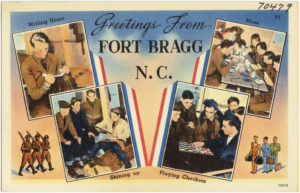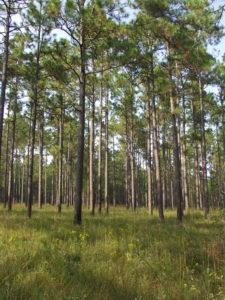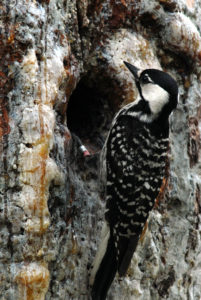You might not expect the establishment of a military base to receive attention on a conservation history calendar. For two reasons, however, one specific and one general, Fort Bragg serves as a great reminder of the importance of military lands to conservation.
Fort Bragg was established on September 4, 1918, as an ideal training and testing location for artillery warfare. Located in rural southeastern North Carolina, the army base covered a huge area—160,000 acres—but had good railroad access. Camp Bragg, as it was known then, came on line a little late to help in World War I, but it has proved its value since then as a premier training site. It is one of the largest military facilities in the world, with a $1.2 billion budget, 250,000 people living on or near the base and a local economic impact of about $10 billion annually.

Fort Bragg is also a unique environmental site—the first reason why it deserves conservation attention. The longleaf pine ecosystem once covered most of the southeastern U.S. coastal plain, but the majority has been replaced by farming, commercial pine plantations and development. But not Fort Bragg. The base contains one of the largest contiguous longleaf pine regions left in the country, just about half of the base’s total area. The park-like environment, with widely spaced tall, old trees and a richly diverse covering of ground vegetation, is maintained naturally by fire. Whereas fire has been controlled in surrounding areas for a century, small fires have always burned on Fort Bragg—shooting artillery around can make that happen!

Consequently, Fort Bragg has remained an ideal longleaf pine ecosystem. And one particular species really likes it there—the Red-cockaded Woodpecker (with the nickname “RCW”). As longleaf pine declined, so did populations of RCWs, that require large old longleaf pine trees as sites for their nesting cavities. The RCW was listed as an endangered species in 1968.
In 1990, a showdown occurred between the U.S. Fish and Wildlife Service, responsible for rebuilding RCW populations, and the U.S. Army, responsible for maintaining military readiness, when the Fish and Wildlife Service issued a “jeopardy opinion” challenging Fort Bragg’s activities. Could RCWs and training Fort Bragg co-exist, or did one need to be sacrificed for the other? Fortunately, the two federal branches came together for the benefit of both.

Since then, a major recovery project has occurred, with great success. The North Carolina Sandhills Conservation Partnership was created in 2000, including both agencies and local conservation groups. As wildlife biologist Pete Campbell said, “Before the partnership began, the relationship between the military and environmental advocates was strained, especially in regard to the red-cockaded woodpecker.” After the partnership, an intensive monitoring and education program began, active nest sites were protected from training activities, artificial nesting boxes were installed and habitat management expanded.
The results have been nothing short of miraculous. Within a few years—and five years faster than anyone dared to dream—RCWs expanded from 200 breeding pairs to over 500. The species has now been declared “biologically recovered” on the base and in the surrounding area. Training restrictions were relaxed as wildlife specialists and military planners began to understand how soldiers and equipment in the woods could co-exist the birds. One Fort Bragg official said, “We’re no longer adversaries. It’s really just about managing the training lands properly. If Fort Bragg does that, the woodpecker is going to be fine.”
Which brings us to the second reason for discussing military lands and conservation. Military lands in general are havens for wildlife. Think about it. Most military bases have large land holdings, only a small fraction of which is actively used and developed. The rest is undeveloped, left alone to buffer military activities from the surrounding community, reducing noise, disruption and the prying eyes of nosy neighbors. In total, the Department of Defense controls about 30 million acres of land with this strategy.
What could be better for biodiversity? Nothing, apparently. Department of Defense lands (along with US Forest Service lands) hold the highest number of federally protected species—more than Fish and Wildlife Service lands or National Park Service lands. Even more importantly, the density of protected species (species per unit area) on military lands is about six times higher than on other federal lands. Army lands, like Fort Bragg, turn out to be the most valuable, probably because the average Army base is larger than those of other services.
Next time you pass a military base, think of it in two ways. First, of course, it is part of the great system of national defense that protects the U.S. But, second, think that you are passing by a great biodiversity preserve. And if it happens to be Fort Bragg, look up. You might see some paratroopers and a happy RCW flying by!
References:
Benton, Nancy et al. 2008. Conserving Biodiversity on Military Lands: A Guide for Natural Resources Managers, 2008 edition. NatureServe. Available at: http://www.dodbiodiversity.org/Full_Publication_Conserving_Biodiversity_on_Military_Lands.pdf. Accessed July 123, 2018.
Brooks, Drew. 2014. Fort Bragg and red-cockaded woodpecker co=exist comfortably after shift in conservation attitudes. The Fayetteville Observer, Aug 19, 2014. Available at: http://www.fayobserver.com/0c570329-0049-5543-a074-f8ec55604454.html. Accessed July 13, 2018.
Shaeffer, Matthew. Fort Bragg. North Carolina History. Available at: http://northcarolinahistory.org/encyclopedia/fort-bragg/. Accessed July 13, 2018.
US Fish and Wildlife Service. Red-cockaded Woodpecker Recovery: From Conflict to Collaboration. USFWS Endangered Species Program. Available at: https://www.fws.gov/endangered/map/ESA_success_stories/NC/NC_story1/. Accessed July 13, 2018.
